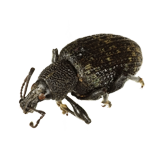
![]() Rotate, Click this tool then
move the mouse overtop of the insect:
Rotate, Click this tool then
move the mouse overtop of the insect:
With the mouse overtop of the insect,
Press-hold the mouse button and drag to rotate up / down / left / right
![]() Zoom, Click this tool then
move the mouse overtop of the insect:
Zoom, Click this tool then
move the mouse overtop of the insect:
Hold the mouse button and drag to zoom-in, or
Click the mouse button without dragging to zoom-out, or
Use the mouse-wheel to zoom in or out
(tip: keep dragging small boxes to zoom-in more and more)
![]() Pan, Click this tool then
move the mouse overtop of the insect:
Pan, Click this tool then
move the mouse overtop of the insect:
Hold the mouse button and drag
![]() Measure, Click this tool then
move the mouse overtop of the insect:
Measure, Click this tool then
move the mouse overtop of the insect:
Hold the mouse button and drag to measure a length
![]() Help,
click this tool to see these instructions
Help,
click this tool to see these instructions
Keyboard Notes
Keyboard Controls
(tip: first click the insect for keyboard-presses to work)Rotate:
Press keyboard "arrows" to rotate left/right/up/down
Zoom:
Hold keyboard "Shift" then "arrows" to zoom in or out
Press keyboard #1 to zoom-out to Life-Size
Press keyboard #0 to zoom-in to Maximum Quality
Pan:
Hold "Ctrl" then "arrows" to pan left/right/up/down
Measure:
Press keyboard "S" to display the current magnification
Supported Systems (no plugins are required)
-
Desktops/laptops:
-
Windows (XP,Vista,Win7,Win8,Win10):
- Chrome
- FireFox
-
Internet Explorer 9 and newer
(only version IE8 requires Java)
-
Mac:
- Chrome
- FireFox
- Safari
-
Google ChromeBook:
- Chrome
-
Linux:
- Chrome
- FireFox
-
Windows (XP,Vista,Win7,Win8,Win10):
-
Tablets: (max zoom-in is less than desktops/laptops)
-
Android:
- Chrome
-
iPad:
- Chrome
- Safari
-
Microsoft Surface RT and Pro:
- Chrome
- Internet Explorer
-
Android:
-
Phones: (max zoom-in is less than desktops/laptops)
-
Android:
- Chrome
-
iPhone:
- Chrome
- Safari
-
Android:
email us at support@BlackholeCollections.org
If you use a different computer system, submit a support request by emailing your computer details.
